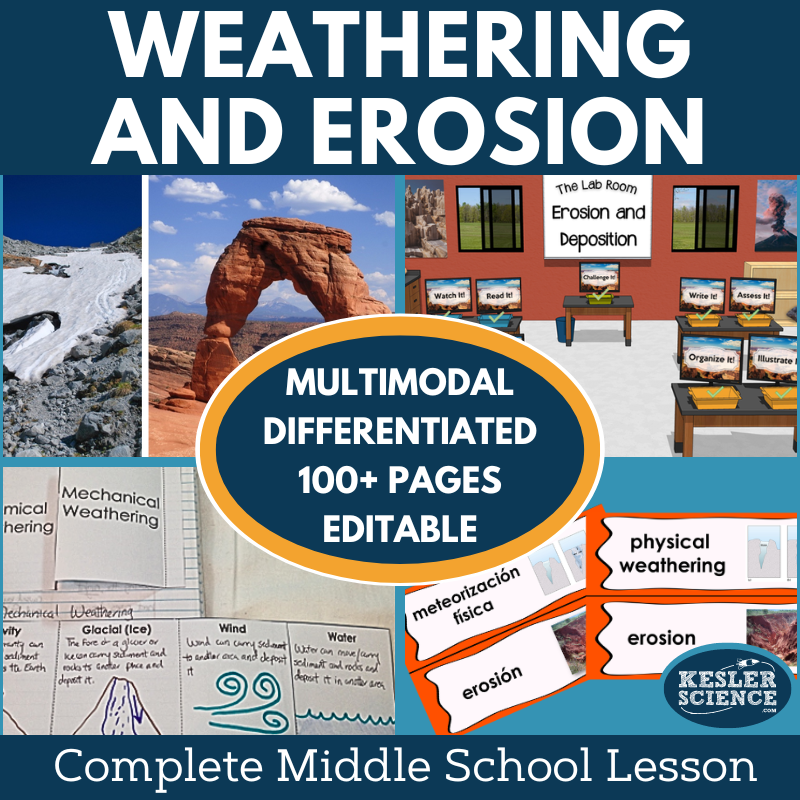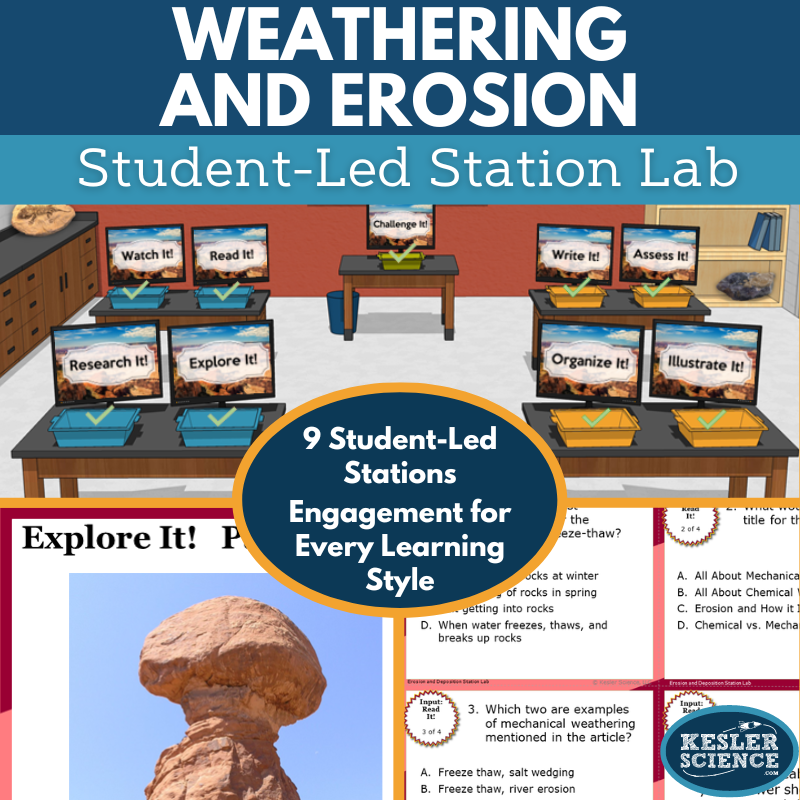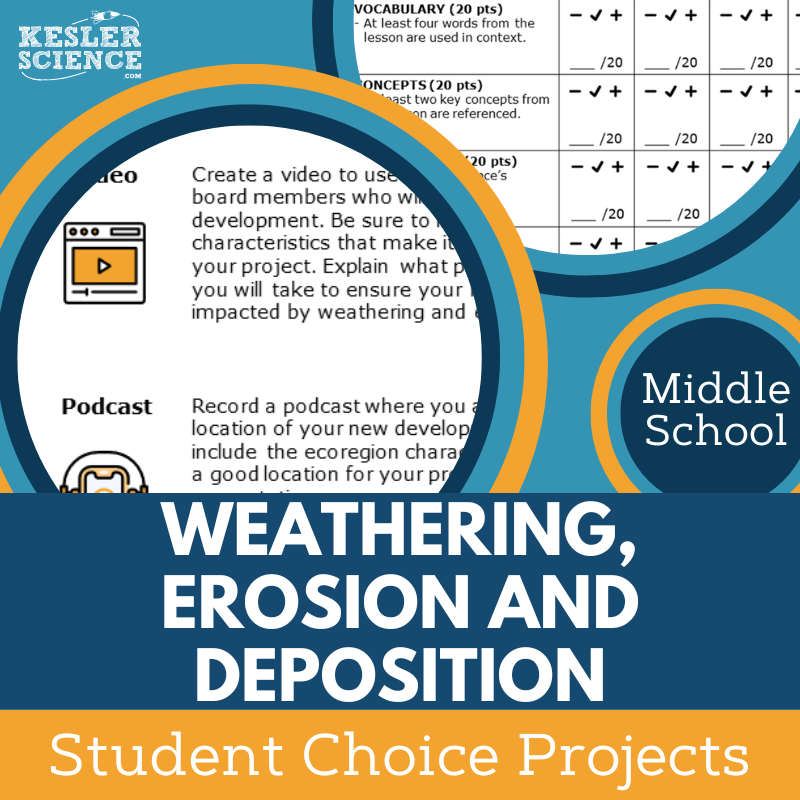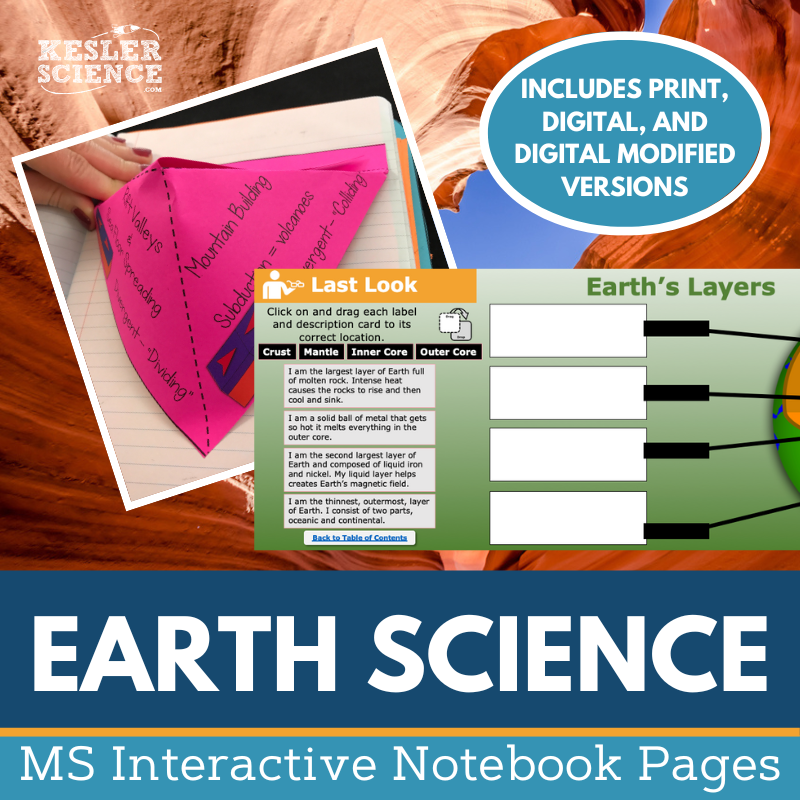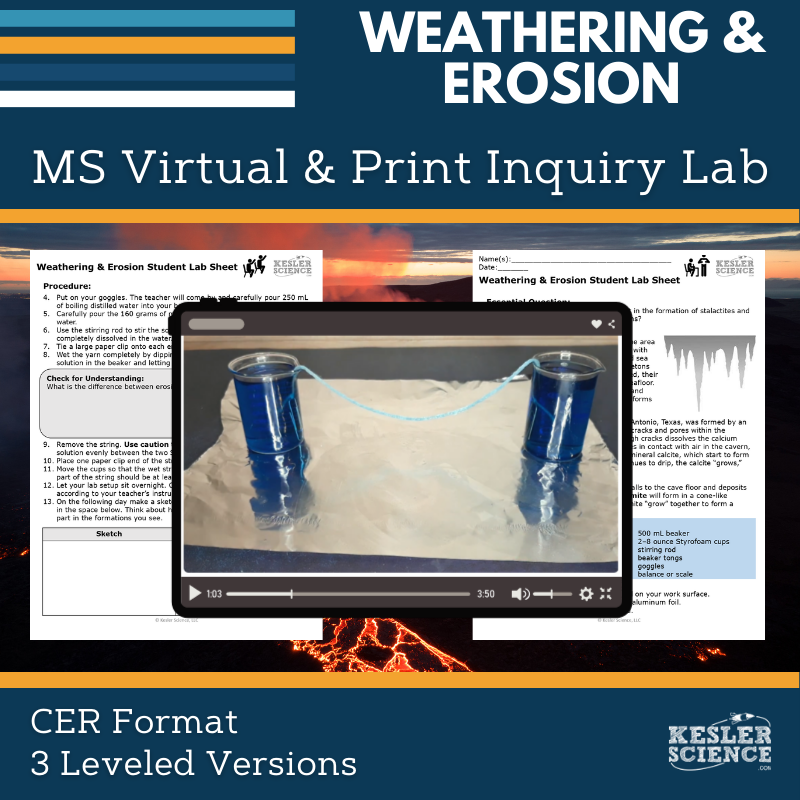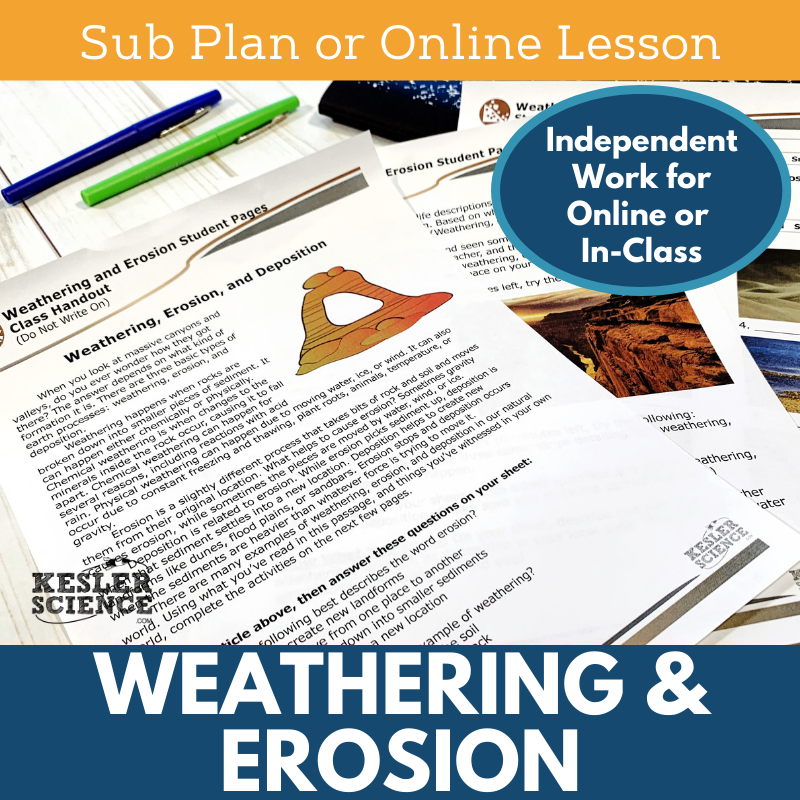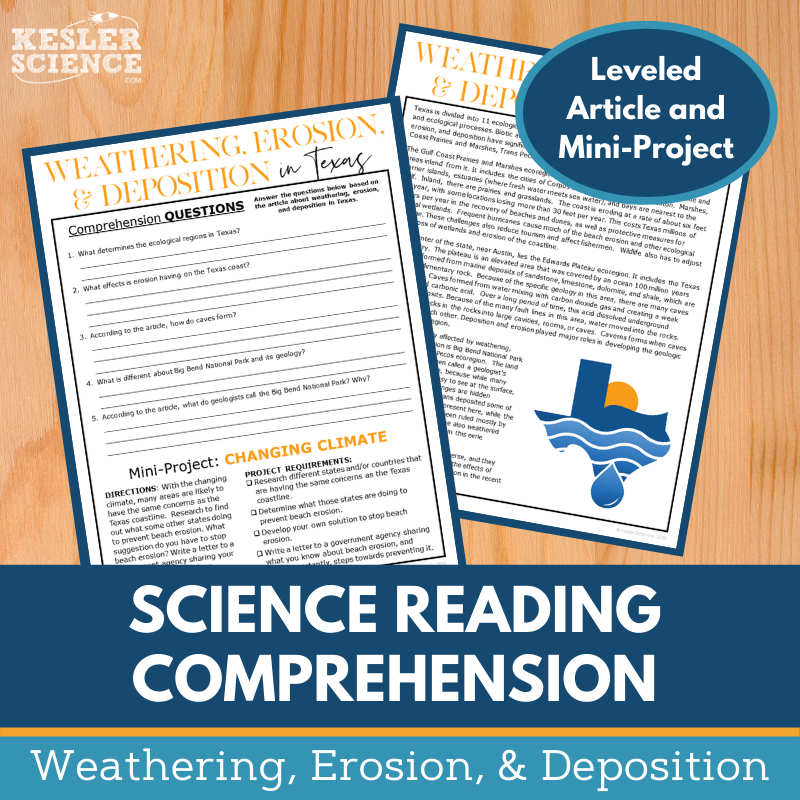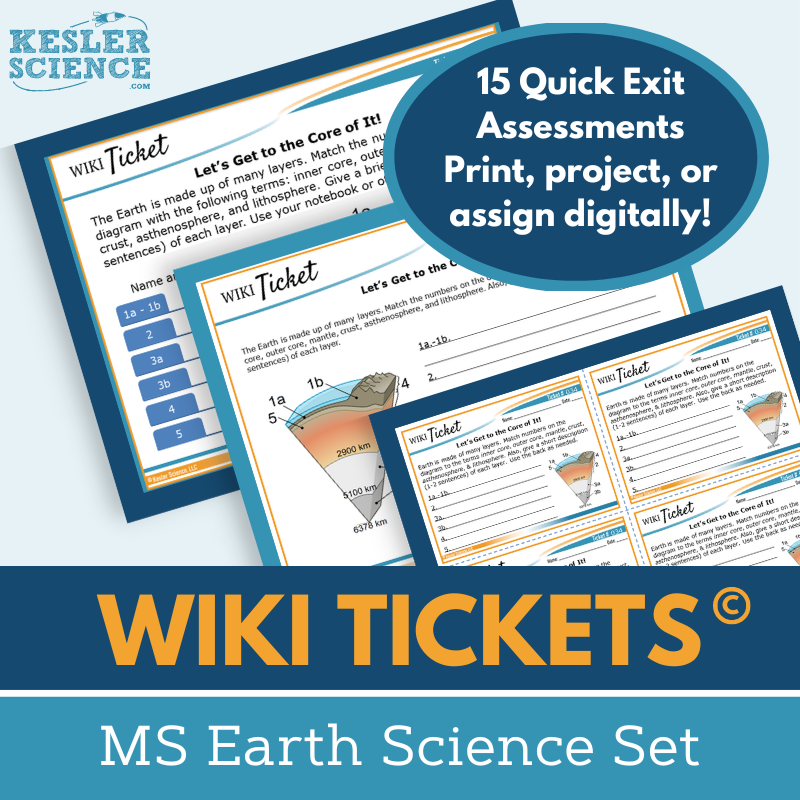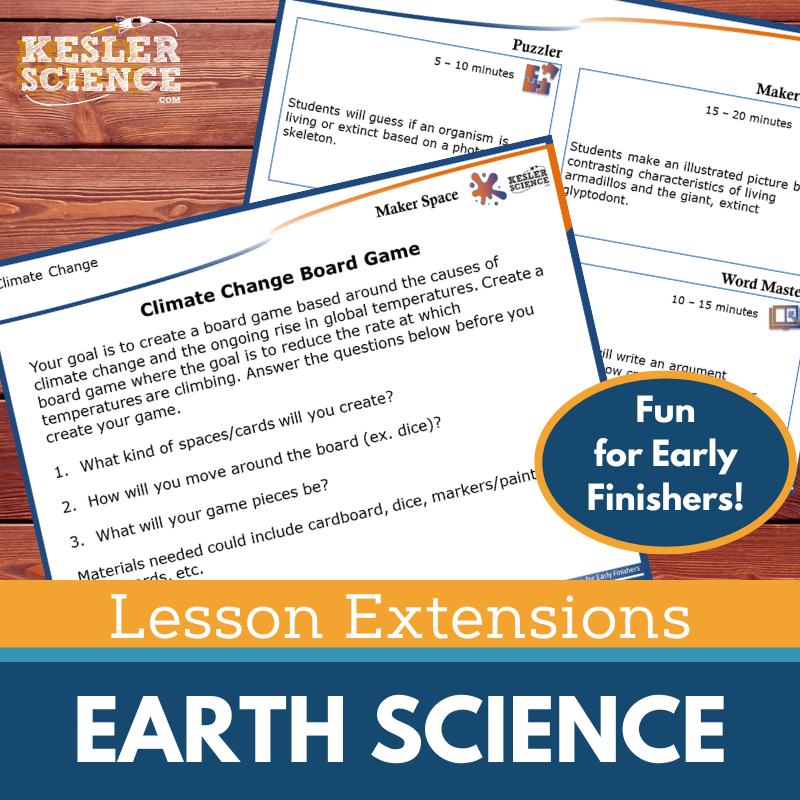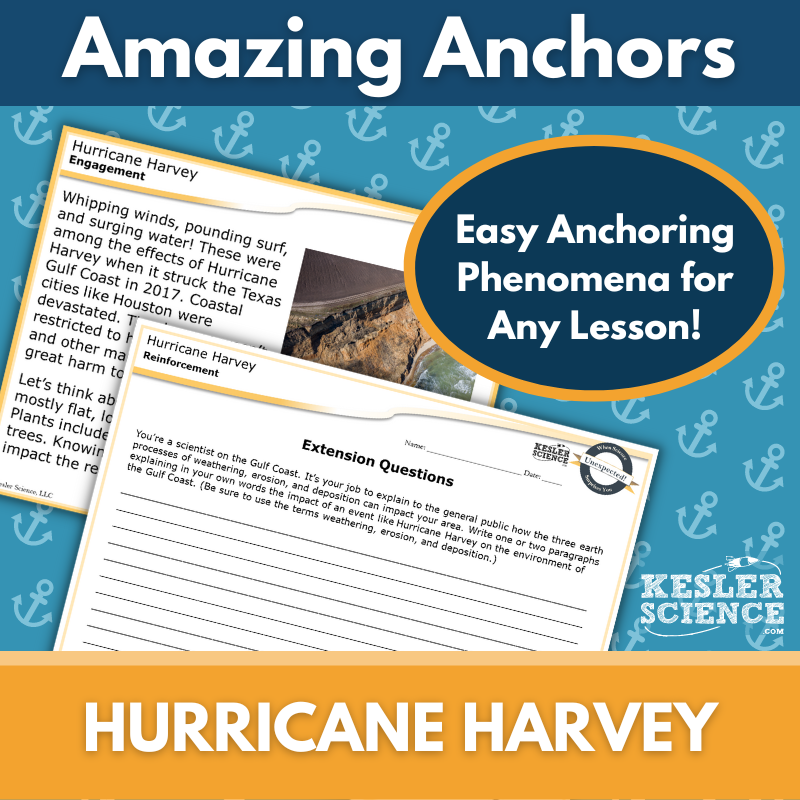Weathering, Erosion, and Deposition Activities for Middle School Science
The Kesler Science Weathering, Erosion, and Deposition resources provide a comprehensive, student-centered approach to teaching the effects of weathering, erosion, and deposition on ecoregions. The resources below will give students a comprehensive understanding of weathering, erosion, and deposition. All of the following materials are also included in the Kesler Science Membership.
The Kesler Science comprehensive Weathering and Erosion 6th-8th Grade 5E Lesson provides everything you need to teach a multi-day unit with minimal prep. Students will explore essential questions about the effects of weathering, erosion, and deposition on ecoregions, while using differentiated, multimodal learning materials. This complete lesson plan is flexible, with printable and digital formats, and includes editable PowerPoints, interactive notebooks, and Spanish translations to support diverse learners.
The lesson follows the 5E Model, covering Engagement, Exploration, Explanation, Elaboration, and Evaluation. In the Engagement phase, students will explore vocabulary through word wall cards and class activities. During Exploration, the student-led station lab offers nine differentiated stations to introduce weathering and erosion in various formats, including hands-on demos, readings, videos, and research tasks. Output stations like "Organize It!" and "Illustrate It!" allow students to demonstrate their understanding.
For Explanation, editable PowerPoints and interactive notebook templates guide students through key concepts, while Elaboration encourages further learning through student-choice projects. In the Evaluation phase, students take part in assessments, with modified versions for various learning needs, and review questions for test practice. This resource is ideal for both in-person and virtual learning environments.
The Kesler Science comprehensive Weathering and Erosion 6th-8th Grade 5E Lesson provides everything you need to teach a multi-day unit with minimal prep. Students will explore essential questions about the effects of weathering, erosion, and deposition on ecoregions, while using differentiated, multimodal learning materials. This complete lesson plan is flexible, with printable and digital formats, and includes editable PowerPoints, interactive notebooks, and Spanish translations to support diverse learners.
The lesson follows the 5E Model, covering Engagement, Exploration, Explanation, Elaboration, and Evaluation. In the Engagement phase, students will explore vocabulary through word wall cards and class activities. During Exploration, the student-led station lab offers nine differentiated stations to introduce weathering and erosion in various formats, including hands-on demos, readings, videos, and research tasks. Output stations like "Organize It!" and "Illustrate It!" allow students to demonstrate their understanding.
For Explanation, editable PowerPoints and interactive notebook templates guide students through key concepts, while Elaboration encourages further learning through student-choice projects. In the Evaluation phase, students take part in assessments, with modified versions for various learning needs, and review questions for test practice. This resource is ideal for both in-person and virtual learning environments.
The Kesler Science Weathering and Erosion Station Lab provides a student-led, modular learning experience that engages middle school students in earth science. With eight differentiated stations, the lab encourages students to construct a scientific explanation about how weathering and erosion shape Earth's resources. The stations include resources such as task cards, literature, and signage to guide students in exploring weathering and erosion processes independently or in small groups.
The station lab includes both input and output stations. Input stations like "Explore It!" and "Research It!" provide hands-on demonstrations, website research, and readings to help students absorb new concepts. Output stations such as "Illustrate It!" and "Write It!" give students opportunities to demonstrate their understanding through sketches, writing, and interactive activities. Additionally, "Challenge It!" offers extension activities for early finishers or advanced students.
This resource is fully adaptable for virtual learning, with digital versions of the stations available for Google Slides or PowerPoint. Teachers can facilitate the lesson remotely or in-person, with comprehensive materials that support student engagement, inquiry, and assessment.
The Kesler Science Weathering and Erosion Station Lab provides a student-led, modular learning experience that engages middle school students in earth science. With eight differentiated stations, the lab encourages students to construct a scientific explanation about how weathering and erosion shape Earth's resources. The stations include resources such as task cards, literature, and signage to guide students in exploring weathering and erosion processes independently or in small groups.
The station lab includes both input and output stations. Input stations like "Explore It!" and "Research It!" provide hands-on demonstrations, website research, and readings to help students absorb new concepts. Output stations such as "Illustrate It!" and "Write It!" give students opportunities to demonstrate their understanding through sketches, writing, and interactive activities. Additionally, "Challenge It!" offers extension activities for early finishers or advanced students.
This resource is fully adaptable for virtual learning, with digital versions of the stations available for Google Slides or PowerPoint. Teachers can facilitate the lesson remotely or in-person, with comprehensive materials that support student engagement, inquiry, and assessment.
The Kesler Science Weathering, Erosion, and Deposition Student Choice Projects provide middle school students with the opportunity to select a project that aligns with their learning style. The project page includes six different student-led project options along with a "design your own" option. A grading rubric allows for assessment by the teacher, peers, or students themselves, ensuring flexibility in evaluation.
This resource includes nine project options plus the "design your own" choice, along with teacher directions and editable rubrics that assess vocabulary, concepts, presentation, clarity, and accuracy. The rubric can be adapted to suit different grading needs, and students can work independently or in groups to complete their chosen project.
The Student Choice Projects are differentiated to meet a variety of needs. The modified version includes options to support students who need remediation, while more advanced learners can be challenged with a combination of projects. Projects require basic classroom supplies like paper, markers, and scissors, with many also offering digital completion options.
The Kesler Science Weathering, Erosion, and Deposition Student Choice Projects provide middle school students with the opportunity to select a project that aligns with their learning style. The project page includes six different student-led project options along with a "design your own" option. A grading rubric allows for assessment by the teacher, peers, or students themselves, ensuring flexibility in evaluation.
This resource includes nine project options plus the "design your own" choice, along with teacher directions and editable rubrics that assess vocabulary, concepts, presentation, clarity, and accuracy. The rubric can be adapted to suit different grading needs, and students can work independently or in groups to complete their chosen project.
The Student Choice Projects are differentiated to meet a variety of needs. The modified version includes options to support students who need remediation, while more advanced learners can be challenged with a combination of projects. Projects require basic classroom supplies like paper, markers, and scissors, with many also offering digital completion options.
The Kesler Science Earth Science Interactive Notebook Bundle is a must-have for teachers who want to provide an interactive learning experience in earth science. It includes both print and digital versions, making it a versatile resource for traditional classrooms, 1:1 environments, and distance learning.
The bundle covers a wide range of earth science topics, including continental drift theory, plate boundaries, rocks and minerals, the rock cycle, Earth’s layers, volcanoes, earthquakes, and more. It also features activities like Venn diagrams, topographic maps, and reflection pages to help students demonstrate understanding and make connections between concepts.
The digital version includes a unique interactive notebook PowerPoint, which can be uploaded to Google Slides or learning management systems like MS Teams and Canvas. The paper version provides blank and pre-filled templates, along with color photos to guide students in completing each activity. Both versions come with a teacher answer key and a modified version for students with accommodations.
The Kesler Science Earth Science Interactive Notebook Bundle is a must-have for teachers who want to provide an interactive learning experience in earth science. It includes both print and digital versions, making it a versatile resource for traditional classrooms, 1:1 environments, and distance learning.
The bundle covers a wide range of earth science topics, including continental drift theory, plate boundaries, rocks and minerals, the rock cycle, Earth’s layers, volcanoes, earthquakes, and more. It also features activities like Venn diagrams, topographic maps, and reflection pages to help students demonstrate understanding and make connections between concepts.
The digital version includes a unique interactive notebook PowerPoint, which can be uploaded to Google Slides or learning management systems like MS Teams and Canvas. The paper version provides blank and pre-filled templates, along with color photos to guide students in completing each activity. Both versions come with a teacher answer key and a modified version for students with accommodations.
The Weathering and Erosion Inquiry Lab helps students explore how erosion and deposition contribute to the formation of these features, using Natural Bridge Caverns in Texas as a real-world example. Students will set up a demonstration to simulate the formation process, then make observations and complete reflection activities over a two-day lab. Both digital and print formats are included, each with comprehension questions, Claim-Evidence-Reasoning (C.E.R.) prompts, and reflection opportunities.
Differentiation is built into the lab with three distinct versions: a structured modified version for learners needing support, a guided dependent version for on-level students, and an inquiry-driven independent version for advanced learners. Each version is designed to support student success while encouraging engagement through hands-on or virtual exploration. The materials needed for the print lab include common classroom items like cups, twine, and Epsom salt, while the digital version requires no materials.
Editable PowerPoints, teacher guides, and answer keys simplify preparation and allow for customization. The resources are fully compatible with Google Slides and major learning platforms, making it easy to integrate into your classroom routine. This lab provides a flexible, engaging way to meet science standards while fostering critical thinking and observation skills.
The Weathering and Erosion Inquiry Lab helps students explore how erosion and deposition contribute to the formation of these features, using Natural Bridge Caverns in Texas as a real-world example. Students will set up a demonstration to simulate the formation process, then make observations and complete reflection activities over a two-day lab. Both digital and print formats are included, each with comprehension questions, Claim-Evidence-Reasoning (C.E.R.) prompts, and reflection opportunities.
Differentiation is built into the lab with three distinct versions: a structured modified version for learners needing support, a guided dependent version for on-level students, and an inquiry-driven independent version for advanced learners. Each version is designed to support student success while encouraging engagement through hands-on or virtual exploration. The materials needed for the print lab include common classroom items like cups, twine, and Epsom salt, while the digital version requires no materials.
Editable PowerPoints, teacher guides, and answer keys simplify preparation and allow for customization. The resources are fully compatible with Google Slides and major learning platforms, making it easy to integrate into your classroom routine. This lab provides a flexible, engaging way to meet science standards while fostering critical thinking and observation skills.
The Kesler Science Weathering and Erosion sub plan provides a comprehensive lesson that guides students through a warm-up puzzle, an engaging reading passage, and an infographic activity. Students identify weathering, erosion, and deposition from images, while early finishers can analyze weathering in the Grand Canyon or create a comic strip. The lesson concludes with an assessment or exit ticket, ensuring complete coverage of the topic.
Designed with substitutes in mind, the resource includes detailed instructions, behavior checkpoints, answer keys, and a substitute letter. A digital version allows for distance learning, featuring a Google Form answer sheet and editable PDFs for annotation. The student-centered approach ensures engagement and minimal downtime.
Perfect for substitutes, distance learning, or as a backup plan, these sub plans offer flexible use in ISS, homework, extra credit, or small group settings. Comprehensive support ensures seamless implementation, whether in-class or virtual, making it an invaluable resource for middle school science teachers.
The Kesler Science Weathering and Erosion sub plan provides a comprehensive lesson that guides students through a warm-up puzzle, an engaging reading passage, and an infographic activity. Students identify weathering, erosion, and deposition from images, while early finishers can analyze weathering in the Grand Canyon or create a comic strip. The lesson concludes with an assessment or exit ticket, ensuring complete coverage of the topic.
Designed with substitutes in mind, the resource includes detailed instructions, behavior checkpoints, answer keys, and a substitute letter. A digital version allows for distance learning, featuring a Google Form answer sheet and editable PDFs for annotation. The student-centered approach ensures engagement and minimal downtime.
Perfect for substitutes, distance learning, or as a backup plan, these sub plans offer flexible use in ISS, homework, extra credit, or small group settings. Comprehensive support ensures seamless implementation, whether in-class or virtual, making it an invaluable resource for middle school science teachers.
Students explore the effects of weathering, erosion, and deposition in Texas ecoregions through a nonfiction reading passage. They engage with comprehension questions, research beach erosion, and craft a letter to civic leaders offering improvement ideas. Designed to boost science literacy and reading comprehension, this activity blends critical thinking with real-world applications.
The resource features two leveled articles (Lexile 1100-1300) for grades 6-8, with questions and a hands-on mini-project. Tools like Cornell notes templates and printable graphics enhance understanding, while the differentiated format accommodates diverse learning needs. Perfect for in-class or virtual use, the materials integrate seamlessly with platforms like Google Classroom, MS Teams, and Canvas.
Ideal for sub plans, extra credit, or whole-class instruction, the passage supports unit routines and fosters rich discussions. By analyzing the text and applying concepts to civic engagement, students develop essential skills in textual analysis and science communication.
Students explore the effects of weathering, erosion, and deposition in Texas ecoregions through a nonfiction reading passage. They engage with comprehension questions, research beach erosion, and craft a letter to civic leaders offering improvement ideas. Designed to boost science literacy and reading comprehension, this activity blends critical thinking with real-world applications.
The resource features two leveled articles (Lexile 1100-1300) for grades 6-8, with questions and a hands-on mini-project. Tools like Cornell notes templates and printable graphics enhance understanding, while the differentiated format accommodates diverse learning needs. Perfect for in-class or virtual use, the materials integrate seamlessly with platforms like Google Classroom, MS Teams, and Canvas.
Ideal for sub plans, extra credit, or whole-class instruction, the passage supports unit routines and fosters rich discussions. By analyzing the text and applying concepts to civic engagement, students develop essential skills in textual analysis and science communication.
The Kesler Science Earth Science WIKI Tickets provide formative assessments for 6th-8th grade science topics, offering flexible options to check students' understanding in an engaging format. Each topic includes five versions: a full-screen projection version, three handout sizes (full, split, and quarter-page), and an interactive digital version for Google Slides or PowerPoint.
The Earth Science WIKI Tickets cover a wide range of earth science topics, including minerals, plate tectonics, the rock cycle, and human impact on the environment. Some topics have more than one ticket, but every topic is covered by at least one.
The WIKI Tickets can be used in both in-person and virtual learning environments. They work great as exit tickets, bellringers, or informal assessments during lessons. Teachers can project them, use printable handouts, or assign them digitally for remote students, making them adaptable for any teaching situation.
The Kesler Science Earth Science WIKI Tickets provide formative assessments for 6th-8th grade science topics, offering flexible options to check students' understanding in an engaging format. Each topic includes five versions: a full-screen projection version, three handout sizes (full, split, and quarter-page), and an interactive digital version for Google Slides or PowerPoint.
The Earth Science WIKI Tickets cover a wide range of earth science topics, including minerals, plate tectonics, the rock cycle, and human impact on the environment. Some topics have more than one ticket, but every topic is covered by at least one.
The WIKI Tickets can be used in both in-person and virtual learning environments. They work great as exit tickets, bellringers, or informal assessments during lessons. Teachers can project them, use printable handouts, or assign them digitally for remote students, making them adaptable for any teaching situation.
The Kesler Science Earth Science Lesson Extensions offer engaging activities for fast finishers, fostering critical thinking and creativity. These extensions are designed to scaffold learning for students ready to dive deeper into earth science topics while aligning with NGSS and TEKS standards. They provide a fun yet rigorous way to enhance lessons and keep students focused during independent work or testing.
Each Lesson Extension includes four core activities: a Puzzler to improve problem-solving, a Maker Space to promote STEAM connections, a Tech Connection to demonstrate learning through digital media, and a Word Master activity to integrate creative writing. These activities ensure students engage with the content in a variety of ways, helping reinforce their understanding.
The Lesson Extensions come with teacher directions, answer keys, and both paper and digital versions for flexibility. Perfect for wrapping up lessons or providing enrichment, these extensions cover a wide range of earth science topics like climate change, fossil fuels, and plate tectonics, all while meeting high-level science standards.
The Kesler Science Earth Science Lesson Extensions offer engaging activities for fast finishers, fostering critical thinking and creativity. These extensions are designed to scaffold learning for students ready to dive deeper into earth science topics while aligning with NGSS and TEKS standards. They provide a fun yet rigorous way to enhance lessons and keep students focused during independent work or testing.
Each Lesson Extension includes four core activities: a Puzzler to improve problem-solving, a Maker Space to promote STEAM connections, a Tech Connection to demonstrate learning through digital media, and a Word Master activity to integrate creative writing. These activities ensure students engage with the content in a variety of ways, helping reinforce their understanding.
The Lesson Extensions come with teacher directions, answer keys, and both paper and digital versions for flexibility. Perfect for wrapping up lessons or providing enrichment, these extensions cover a wide range of earth science topics like climate change, fossil fuels, and plate tectonics, all while meeting high-level science standards.
This Amazing Anchors Phenomenon Lesson introduces and reinforces the science of hurricanes through real-world connections. Students begin with a reading on Hurricane Harvey (2017), using comprehension and extension questions to spark curiosity and activate prior knowledge. A second, explanatory reading breaks down how hurricanes affect Earth’s landscape, deepening student understanding with follow-up questions that encourage further exploration.
Aligned with TEKS standards, this no-prep resource includes teacher directions, answer keys, and additional materials to support implementation. Editable resources are provided in full-page projection slides and both full- and half-sheet printable handouts, with digital formats available for Google Classroom or other LMS platforms. A modified version is included to support students with differentiated language and sentence starters.
Designed to bookend any earth science lesson, this resource is ideal for the Engage and Elaborate phases of the 5E Model. The hurricane-themed readings and activities serve as compelling supplements that connect science content to the real world, whether used in person or virtually.
This Amazing Anchors Phenomenon Lesson introduces and reinforces the science of hurricanes through real-world connections. Students begin with a reading on Hurricane Harvey (2017), using comprehension and extension questions to spark curiosity and activate prior knowledge. A second, explanatory reading breaks down how hurricanes affect Earth’s landscape, deepening student understanding with follow-up questions that encourage further exploration.
Aligned with TEKS standards, this no-prep resource includes teacher directions, answer keys, and additional materials to support implementation. Editable resources are provided in full-page projection slides and both full- and half-sheet printable handouts, with digital formats available for Google Classroom or other LMS platforms. A modified version is included to support students with differentiated language and sentence starters.
Designed to bookend any earth science lesson, this resource is ideal for the Engage and Elaborate phases of the 5E Model. The hurricane-themed readings and activities serve as compelling supplements that connect science content to the real world, whether used in person or virtually.
Year-Round Resources
These year-round activities will increase your students' understanding of many middle school science topics. All of these activities are also included in the Kesler Science Membership.
Visual Data & Graphing
You're not alone if your students struggle with understanding graphs, charts, and tables. It's a skill that takes an enormous amount of practice. This resource will help students build a strong foundation in analyzing data and creating their own data visualizations.
Bell Ringers and Warm-Ups
These middle school science bell ringers are an excellent way to engage your students as soon as they walk into your classroom. This comprehensive FULL YEAR resource includes everything you need to start off each science class with an interesting warm-up activity.
Review Board Games
Each game board has been carefully designed to keep students engaged. There are 10 different action spaces on each board and dozens of question cards. All of the actions are related to science concepts and keep the students motivated throughout the game.
Each game is ready to play. Simply print out the board and the cards and let the students enjoy reviewing nine different units.
Essential Questions
Below are the essential questions associated with the lessons and activities included in this unit. This topic is only one of more than 100 middle school science topics included in the Kesler Science Membership.
-
What effects does weathering have on the environment in ecoregions?
-
What effects does erosion have on the environment in ecoregions?
-
What effects does deposition have on the environment in ecoregions?
Kesler Science Membership
Imagine never having to search for another middle school science lesson again. The membership gives you access to ALL of the Kesler Science products in one place (Yes, including everything above).
Say goodbye to long hours of lesson prep.

